Basal cell carcinoma (overview) Images
Go to article Basal cell carcinoma (overview)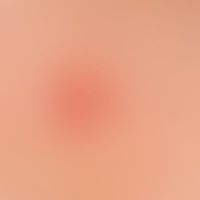
Basal cell carcinoma nodular:slowly growing, smooth surface, somewhat reddish, symptomless, firm lump.
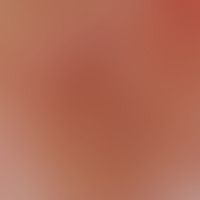
Basal cell carcinoma nodular: bizarre tumor vessels in reflected light microscopy.

Nodular or nodular basal cell carcinoma: Relatively inconspicuous, non-symptomatic, red nodule with a smooth surface (see incident light image as inlet); the bizarre (tumor) vessels of the basal cell carcinoma become visible in incident light.


Basal cell carcinoma nodular: probably existing for years, slowly growing, skin-coloured, bumpy, completely painless plaque that slides over the base; the destructive growth is recognizable by the undercut of the hairline (hair destroyed).
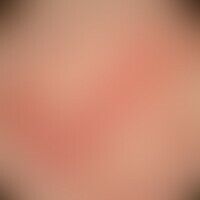
Basal cell carcinoma nodular: probably existing for years, slowly growing, skin-coloured, bumpy, completely painless plaque that slides over the base; bizarre vessels with calibre irregularities; destructive growth with destruction of the hair appendages.
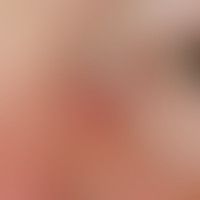
Basal cell carcinoma nodular: surface-smooth, reddish nodule with marginal bizarre vascular ectasia.

Basal cell carcinoma nodular: detailed picture; surface smooth, reddish nodule with bizarre vascular ectasia at the edges (marked by arrows); a telangiectatic vessel is also encircled.

Basal cell carcinoma (overview): Nodular, centrally ulcerated basal cell carcinoma.
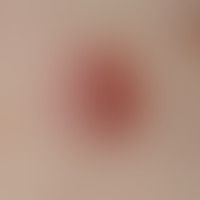
Basal cell carcinoma (overview): Nodular basal cell carcinoma with a shiny, smooth surface interspersed with bizarre telangiectases.


Basal cell carcinoma (overview): Nodular, centrally decaying basal cell carcinoma, excessive spread; diagnostically important are the bizarre, large-calibre tumour vessels that extend mainly over the peripheral areas.
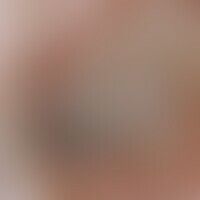
basal cell carcinoma. incident light microscopy: bizarre, irregular tumor vessels, which in this shape and arrangement are almost proof of basal cell carcinoma. important: the incident light microscope should only be applied to the surface with minimal contact pressure. stronger contact pressure leads to a compression of the vessels, which then can no longer be displayed.

Basal cell carcinoma nodular: Irregularly configured, hardly painful, borderline red nodule (here the clinical suspicion of a basal cell carcinoma can be raised: nodular structure, shiny surface, telangiectasia); extensive decay of the tumor parenchyma in the center of the nodule.

Basal cell carcinoma (overview): Partly sclerodermiform, partly nodular, sharply defined basal cell carcinoma.


Basal cell carcinoma: advanced extensive ulcerated nodular basal cell carcinoma with a shiny wall on the lower left side which is of diagnostic relevance for basal cell carcinoma.


Basal cell carcinoma superficial: plaque with a prominent edge, scarred in the centre and completely asymptomatic for years; the edge is the diagnostic "signal" of superficial basal cell carcinoma and can be "highlighted" by stretching the surrounding skin.
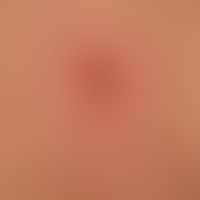
Basal cell carcinoma superficial: plaque with an accentuated margin, in the centre (scarring), completely asymptomatic for years (detailed picture); now formation of a weeping nodule; the marginal area is the diagnostic "signal" of the superficial basal cell carcinoma and can be "emphasized" by stretching the surrounding skin

Basal cell carcinoma superficial: Plaque emphasized at the edge, in the center (scarring), completely without symptoms for years (detailed picture). Now formation of a weeping node (arrows) The edge area (square) is the diagnostic "signal" of the superficial basal cell carcinoma and can be "emphasized" by stretching the surrounding skin. Encircled "scarred" whitish areas without follicular structure (comparison: normally structured skin highlighted by a triangle).

basal cell carcinoma superficial. eczema-like aspect. only in the marginal area a smooth shiny seam can be detected when enlarged. this seam is the diagnostic "signal" of the superficial basal cell carcinoma and can be "emphasized" by stretching the surrounding skin.
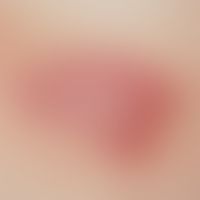
Basal cell carcinoma (overview): Basal cell carcinoma superficial, detailed view.
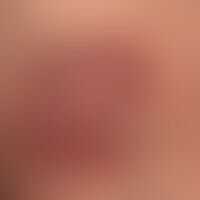
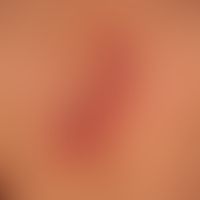
Basal cell carcinoma superficial: slowly growing, symptom-free red plaque with crusty edges, which has been present for several years.
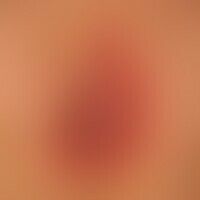

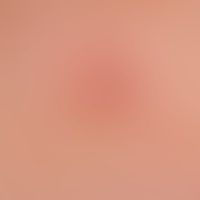
Basal cell carcinoma sclerodermiformes: inconspicuous, whitish plaque with skin-coloured, light raised edges.

Basal cell carcinoma pigmented
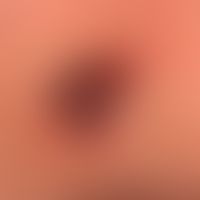
Detailed view: The diagnosis "pigmented basal cell carcinoma" is visible at the left margin, where the spatter-like hyperpigmentation is found (accumulation of melanin clods in the tumor parenchyma, caused by the "accompanying proliferation" of melanocytes). At the upper pole local tumor decay and ulceration.

Basal cell carcinoma: inconspicuous, nodular, centrally flat ulcerated nodule covered with a thin brownish crust, completely painless, flat nodule. Marginal area reaching up to the red of the lips. Drawing of the operation scheme.

basal cell carcinoma (overview): basal cell carcinoma pigmented. superficial (superficial), multi-segmental, symptomless, partly smooth, partly scaly plaque. arrows mark the pigmented nodular structure in the marginal area. encircles the prominent marginal structure in the "depigmented" part of the tumor. differential diagnosis excludes a malignant melanoma of the SSM type.

Basal cell carcinoma pigmented: blue-black symptomless, slowly growing lump, centrally ulcerated .

Basal cell carcinoma nodular (centrally ulcerated), the bizarre vascular structures are characteristic (visible at the lower edge of the nodule - reflected light microscopy).

Basal cell carcinoma nodular (centrally ulcerated). reflected light microscopy with bizarre vascular structures (tumor vessels) at the lower edge of the nodule.


Basal cell carcinoma destructive: progressive destruction of the nasal cartilage by the infiltrating tumor over many years.

Basal cell carcinoma ulcerated: large-area, nodular, non-painful basal cell carcinoma, untreated for years. initially surface intact nodule. for 1/2 year crust formation with ulcer formation. HIV-infected person.


Basal cell carcinoma, nodular: Development of a basal cell carcinoma on a (congenital) sebaceous nevus. The carcinomatous transformation took place chronically insidiously without any symptoms. Only a recurring crust formation with intermediate weeping led to the pioneering biopsy.



Basal cell carcinoma ulcerated: skin change existing for years. Initially symptomless nodule, increasing surface growth, central ulcer formation. Typical for the diagnosis "basal cell carcinoma" is the raised, glassy appearing border wall.
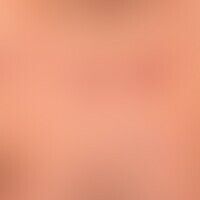


The 5 most frequent localizations of basal cell carcinoma: Data from the Mannheim Skin Tumor Center (2004-2013). n. Lobeck A et al. 2017


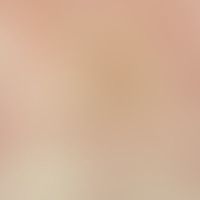
Basal cell carcinoma: reflected-light microscopic initial findings of laser scanning microscopy.

Basal cell carcinoma: Incident light microscopy as the initial finding for laser scanning microscopy.

Basal cell carcinoma: laser scanning microscopy, overview

Basal cell carcinoma: laser scanning microscopy, detailed image, tumor nest with palisade position of the cells and optical slit

Basal cell carcinoma: laser scanning microscopy, overview

Basal cell carcinoma: laser scanning microscopy, detail with tumor nests, palisade position of the cells, optical slit

Basal cell carcinoma: laser scanning microscopy, detail with tumor nests, palisade position of the cells









